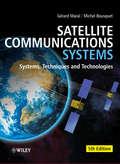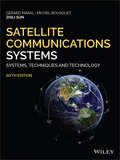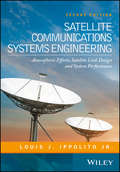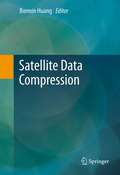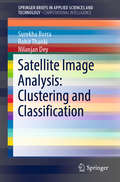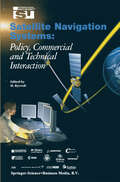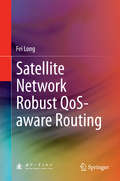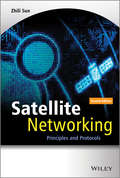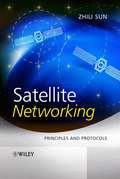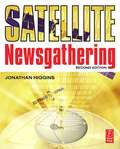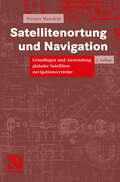- Table View
- List View
Satellite Communications Systems: Systems, Techniques and Technology
by Gerard Maral Michel BousquetRevisions to 5th Edition by: Zhili Sun, University of Surrey, UK New and updated edition of this authoritative and comprehensive reference to the field of satellite communications engineering Building on the success of previous editions, Satellite Communications Systems, Fifth Edition covers the entire field of satellite communications engineering from orbital mechanics to satellite design and launch, configuration and installation of earth stations, including the implementation of communications links and the set-up of the satellite network. This book provides a comprehensive treatment of satellite communications systems engineering and discusses the technological applications. It demonstrates how system components interact and details the relationship between the system and its environment. The authors discuss the systems aspects such as techniques enabling equipment and system dimensioning and state of the art technology for satellite platforms, payloads and earth stations. New features and updates for the fifth edition include: More information on techniques allowing service provision of multimedia content Extra material on techniques for broadcasting, including recent standards DVB-RCS and DVB-S2 (Digital Video Broadcasting -Return Channel Satellite and -Satellite Version 2) Updates on onboard processing By offering a detailed and practical overview, Satellite Communications Systems continues to be an authoritative text for advanced students, engineers and designers throughout the field of satellite communications and engineering.
Satellite Communications Systems: Systems, Techniques and Technology
by Gerard Maral Michel Bousquet Zhili SunThe revised and updated sixth edition of Satellite Communications Systems contains information on the most recent advances related to satellite communications systems, technologies, network architectures and new requirements of services and applications. The authors – noted experts on the topic – cover the state-of-the-art satellite communication systems and technologies and examine the relevant topics concerning communication and network technologies, concepts, techniques and algorithms. New to this edition is information on internetworking with the broadband satellite systems, more intensive coverage of Ka band technologies, GEO high throughput satellite (HTS), LEO constellations and the potential to support the current new broadband Internet services as well as future developments for global information infrastructure. The authors offer details on digital communication systems and broadband networks in order to provide high-level researchers and professional engineers an authoritative reference. The companion website provides slides for instructors to teach and for students to learn. In addition, the book is designed in a user-friendly format.
Satellite Communications Systems: Systems, Techniques and Technology
by Gerard Maral Michel Bousquet Zhili SunThe revised and updated sixth edition of Satellite Communications Systems contains information on the most recent advances related to satellite communications systems, technologies, network architectures and new requirements of services and applications. The authors – noted experts on the topic – cover the state-of-the-art satellite communication systems and technologies and examine the relevant topics concerning communication and network technologies, concepts, techniques and algorithms. New to this edition is information on internetworking with the broadband satellite systems, more intensive coverage of Ka band technologies, GEO high throughput satellite (HTS), LEO constellations and the potential to support the current new broadband Internet services as well as future developments for global information infrastructure. The authors offer details on digital communication systems and broadband networks in order to provide high-level researchers and professional engineers an authoritative reference. The companion website provides slides for instructors to teach and for students to learn. In addition, the book is designed in a user-friendly format.
Satellite Communications Systems Engineering: Atmospheric Effects, Satellite Link Design and System Performance (Wireless Communications And Mobile Computing Ser.)
by Louis J. Ippolito Jr.The first edition of Satellite Communications Systems Engineering (Wiley 2008) was written for those concerned with the design and performance of satellite communications systems employed in fixed point to point, broadcasting, mobile, radio navigation, data relay, computer communications, and related satellite based applications. This welcome Second Edition continues the basic premise and enhances the publication with the latest updated information and new technologies developed since the publication of the first edition. The book is based on graduate level satellite communications course material and has served as the primary text for electrical engineering Masters and Doctoral level courses in satellite communications and related areas. Introductory to advanced engineering level students in electrical, communications and wireless network courses, and electrical engineers, communications engineers, systems engineers, and wireless network engineers looking for a refresher will find this essential text invaluable.
Satellite Communications Systems Engineering: Atmospheric Effects, Satellite Link Design and System Performance
by Louis J. Ippolito Jr.The first edition of Satellite Communications Systems Engineering (Wiley 2008) was written for those concerned with the design and performance of satellite communications systems employed in fixed point to point, broadcasting, mobile, radio navigation, data relay, computer communications, and related satellite based applications. This welcome Second Edition continues the basic premise and enhances the publication with the latest updated information and new technologies developed since the publication of the first edition. The book is based on graduate level satellite communications course material and has served as the primary text for electrical engineering Masters and Doctoral level courses in satellite communications and related areas. Introductory to advanced engineering level students in electrical, communications and wireless network courses, and electrical engineers, communications engineers, systems engineers, and wireless network engineers looking for a refresher will find this essential text invaluable.
Satellite Data Compression: 31 July-1 August, 2005, San Diego, California, Usa (Proceedings Of Spie Ser. #5889)
by Bormin HuangSatellite Data Compression covers recent progress in compression techniques for multispectral, hyperspectral and ultra spectral data. A survey of recent advances in the fields of satellite communications, remote sensing and geographical information systems is included. Satellite Data Compression, contributed by leaders in this field, is the first book available on satellite data compression. It covers onboard compression methodology and hardware developments in several space agencies. Case studies are presented on recent advances in satellite data compression techniques via various prediction-based, lookup-table-based, transform-based, clustering-based, and projection-based approaches. This book provides valuable information on state-of-the-art satellite data compression technologies for professionals and students who are interested in this topic. Satellite Data Compression is designed for a professional audience comprised of computer scientists working in satellite communications, sensor system design, remote sensing, data receiving, airborne imaging and geographical information systems (GIS). Advanced-level students and academic researchers will also benefit from this book.
Satellite Image Analysis: Clustering and Classification (SpringerBriefs in Applied Sciences and Technology)
by Surekha Borra Rohit Thanki Nilanjan DeyThanks to recent advances in sensors, communication and satellite technology, data storage, processing and networking capabilities, satellite image acquisition and mining are now on the rise. In turn, satellite images play a vital role in providing essential geographical information. Highly accurate automatic classification and decision support systems can facilitate the efforts of data analysts, reduce human error, and allow the rapid and rigorous analysis of land use and land cover information. Integrating Machine Learning (ML) technology with the human visual psychometric can help meet geologists’ demands for more efficient and higher-quality classification in real time. This book introduces readers to key concepts, methods and models for satellite image analysis; highlights state-of-the-art classification and clustering techniques; discusses recent developments and remaining challenges; and addresses various applications, making it a valuable asset for engineers, data analysts and researchers in the fields of geographic information systems and remote sensing engineering.
Satellite Navigation Systems: Policy, Commercial and Technical Interaction (Space Studies #8)
by M. RycroftT. Ito, International Space University, Strasbourg Central Campus, 1 Rue Jean Dominique Cassini, Parc d'Innovation, 67400 lllkirch-Graffenstaden, France e-mail: ito@isu. isunet. edu M. J. Rycroft, CAESAR Consultancy, 35 Millington Road, Cambridge CB3 9HW, UK e-mail: Michael. J. Rycroft®ukgateway. net As Symposium Committee Chair for the 2003 International Space University (ISU) Symposium, and Editor of this Proceedings volume, respectively, we write this introduction. The success of previous ISU symposia suggests that the ISU has developed a unique and winning formula for a novel type of symposium. The characteristics of ISU symposia are that they: • Adopt a broad, and interdisciplinary, perspective • Address all aspects of the subject, ranging from policy, business, organisational, and legal issues to technical and scientific topics • Foster a constructive dialogue among very different sectors of the space community, and • Allow ample time for interactive discussions. The present Symposium is no exception. It considers the very timely topic of space-based systems for global positioning and navigation, ranging from the GPS system developed by the US military to the Russian GLONASS system, and on to the future European Galileo system. Other nations are planning regional augmentation systems.
Satellite Network Robust QoS-aware Routing
by Fei LongSatellite Network Robust QoS-aware Routing presents a novel routing strategy for satellite networks. This strategy is useful for the design of multi-layered satellite networks as it can greatly reduce the number of time slots in one system cycle. The traffic prediction and engineering approaches make the system robust so that the traffic spikes can be handled effectively. The multi-QoS optimization routing algorithm can satisfy various potential user requirements. Clear and sufficient illustrations are also presented in the book. As the chapters cover the above topics independently, readers from different research backgrounds in constellation design, multi-QoS routing, and traffic engineering can benefit from the book.Fei Long is a senior engineer at Beijing R&D Center of 54th Research Institute of China Electronics Technology Group Corporation.
Satellite Networking: Principles and Protocols
by Zhili SunThis book provides up to date coverage of the basics of ATM and internet protocols, and characteristics of satellite networks and internetworking between satellite and terrestrial networks Satellite Networking: Principles and Protocols, Second Edition provides up to date information of the original topics in satellite networking and protocols focusing on Internet Protocols (IP) over satellites, broadband over satellites, next generation IP (IPv6) over satellites, new generation of DVB-S/S2 and DVB-RCS next generations and new services and applications. It also includes some analytical techniques for evaluation of end to end IP performance and QoS over satellite, reflecting the recent convergence of telecommunication, Internet, broadcasting and mobile networks. Topics new to this edition: Internetworking with MANET, DVB-S/S2 and DVB-RCS/RCS2 (including TCP/IP over DVB-S/RCS), recent developments in broadband satellite systems, convergence of services and network technologies (including Internet, telecom, mobile, TV, etc.), radio resource management, PEP, I-PEP, SCPS, traffic modelling and engineering with analysis and examples, and future developments of satellite networking. Provides up to date coverage of the basics of ATM and internet protocols, and characteristics of satellite networks and internetworking between satellite and terrestrial networks (e.g. mobile ad hoc networks), including coverage of new services and applications (e.g. Internet, telecom, mobile and TV) Discusses the real-time protocols including RTP, RTCP and SIP for real-time applications such as VoIP and MMC, and explains TCP/IP over satellite and evolution of IPv6 over satellite and beyond
Satellite Networking: Principles and Protocols
by Zhili SunThis book provides up to date coverage of the basics of ATM and internet protocols, and characteristics of satellite networks and internetworking between satellite and terrestrial networks Satellite Networking: Principles and Protocols, Second Edition provides up to date information of the original topics in satellite networking and protocols focusing on Internet Protocols (IP) over satellites, broadband over satellites, next generation IP (IPv6) over satellites, new generation of DVB-S/S2 and DVB-RCS next generations and new services and applications. It also includes some analytical techniques for evaluation of end to end IP performance and QoS over satellite, reflecting the recent convergence of telecommunication, Internet, broadcasting and mobile networks. Topics new to this edition: Internetworking with MANET, DVB-S/S2 and DVB-RCS/RCS2 (including TCP/IP over DVB-S/RCS), recent developments in broadband satellite systems, convergence of services and network technologies (including Internet, telecom, mobile, TV, etc.), radio resource management, PEP, I-PEP, SCPS, traffic modelling and engineering with analysis and examples, and future developments of satellite networking. Provides up to date coverage of the basics of ATM and internet protocols, and characteristics of satellite networks and internetworking between satellite and terrestrial networks (e.g. mobile ad hoc networks), including coverage of new services and applications (e.g. Internet, telecom, mobile and TV) Discusses the real-time protocols including RTP, RTCP and SIP for real-time applications such as VoIP and MMC, and explains TCP/IP over satellite and evolution of IPv6 over satellite and beyond
Satellite Networking: Principles and Protocols
by Zhili SunSatellite networking is an exciting and expanding field that has evolved significantly since the launch of the first telecommunications satellite, from telephone and broadcast to broadband ATM and Internet. With increasing bandwidth and mobility demands on the horizon, satellites have become an integral part of the Global Network Infrastructure (GNI). Satellite Networking: Principles and Protocols provides a balanced coverage of satellite topics from a network point of view, focusing on network aspects, services and applications, quality of service (QoS) and principles and protocols. Introduces the basics of ATM and internet protocols, and characteristics of satellite networks and internetworking between satellite and terrestrial networks Discusses the real-time protocols including RTP, RTCP and SIP for real-time applications such as VoIP and MMC Coverage of new services and applications, internet traffic engineering and MPLS Examines IPv6 over satellite using tunnelling and translation techniques, evolution of earth stations, user terminals and network protocols, and development of satellite networking Includes a Companion Website featuring: Solutions manual, and electronic versions of the figures This text is essential reading for senior undergraduates, postgraduates, and researchers in the fields of satellites, communications and networks. It will also have instant appeal to engineers, managers and operators in these fields.
Satellite Newsgathering
by Jonathan HigginsPraise for the first edition:"It is a wonderful source of information and has the merit of going straight to the subject, being technically precise although very easy to understand. There are numerous pictures, photographs, diagrams, which make the reading a real pleasure." --European Broadcasting Union Technical Review "The complexity of a satellite newsgathering system could be a four-month long college course with a high tuition rate and an enrolment number so large you have to watch your professor on a TV screen. Jonathan Higgins might have saved the independent learner a few attendance point deductions by fitting it into one book." --Satellite Broadband magazineAn ideal introduction for anyone working, or interested, in satellite newsgathering (SNG). The new edition of this popular book builds upon the success of the first--an important and valuable work that is extermely easy to read, comprehensive in its treatment, and detailed where necessary. SNG used to be an immensely complex and expensive affair where broadcasting organizations were at the mercy of an expert who sat in a lonely corner, until needed. Things have changed--everyone in a global news organization needs to know about it now. This is not only because of the high costs of mistakes, but because now even non-technical journalists on the ground have to operate their own equipment. Learn the skills, basics of equipment, cutting edge technology and critical safety issues of satellite newsgathering.
Satellite Newsgathering
by Jonathan HigginsPraise for the first edition:"It is a wonderful source of information and has the merit of going straight to the subject, being technically precise although very easy to understand. There are numerous pictures, photographs, diagrams, which make the reading a real pleasure." --European Broadcasting Union Technical Review "The complexity of a satellite newsgathering system could be a four-month long college course with a high tuition rate and an enrolment number so large you have to watch your professor on a TV screen. Jonathan Higgins might have saved the independent learner a few attendance point deductions by fitting it into one book." --Satellite Broadband magazineAn ideal introduction for anyone working, or interested, in satellite newsgathering (SNG). The new edition of this popular book builds upon the success of the first--an important and valuable work that is extermely easy to read, comprehensive in its treatment, and detailed where necessary. SNG used to be an immensely complex and expensive affair where broadcasting organizations were at the mercy of an expert who sat in a lonely corner, until needed. Things have changed--everyone in a global news organization needs to know about it now. This is not only because of the high costs of mistakes, but because now even non-technical journalists on the ground have to operate their own equipment. Learn the skills, basics of equipment, cutting edge technology and critical safety issues of satellite newsgathering.
Satellite Personal Communications for Future-generation Systems: Final Report: COSY 252 Action
by Enrico Del Re Laura PierucciConsisting of selected technical contributions to the European Project COST252, this volume provides many innovative results which can be the basis for new global telecommunications systems providing multimedia services at high rates. It also presents new perspectives on communications problems in various areas.
Satellite Systems for Personal and Broadband Communications
by E. Lutz M. Werner A. JahnA scientific overview of current and future satellite systems for mobile and broadband communications. In part I, the fundamentals of geostationary and non-geostationary satellite constellations and the related questions of communications technology are treated. Part II deals with satellite systems for mobile communications and treats several network features as well as their technology, regulation and financing. Part III is devoted to future satellite systems for broadband communications and explains the specialities of satellite communications, particularly on the basis of ATM and TCP/IP. An extensive survey on operating and planned satellite systems completes the book.
Satellite Systems for Personal Applications: Concepts and Technology (Wireless Communications and Mobile Computing #22)
by Madhavendra Richharia Leslie David WestbrookPresents the concepts, technology, and role of satellite systems in support of personal applications, such as mobile and broadband communications, navigation, television, radio and multimedia broadcasting, safety of life services, etc. This book presents a novel perspective on satellite systems, reflecting the modern personal technology context, and hence a focus on the individual as end-user. The book begins by outlining key generic concepts before discussing techniques adopted in particular application areas; next, it exemplifies these techniques through discussion of state-of-art current and emerging satellite systems. The book concludes by contemplating the likely evolution of these systems, taking into consideration influences and trends in technology, in conjunction with growing user expectations. In addition to addressing satellite systems that directly interact with personal devices, the book additionally considers those indirect applications where there is an increasing interest by individuals - notably, in remote sensing. As such, the book uniquely encompasses the entire gamut of satellite-enabled personal / end-user applications. Key Features: Broad scope - views satellite systems generically with regards to their applicability across a wide range of personal application areas Strong foundation in underlying concepts State-of-the-art system examples Review of trends in relevant areas of satellite technology Revision questions at the end of each chapter The book is suited to individuals, engineers, scientists, service providers, system operators, application developers and managers interested or involved in the use of satellite technology for personal applications. It should also hold interest for use in research institutes interested in promoting inter-disciplinary cross-fertilization of ideas, as well as by financiers, policy makers, and strategists interested in gaining a better understanding of this technology.
Satellite Systems for Personal Applications: Concepts and Technology (Wireless Communications and Mobile Computing #18)
by Madhavendra Richharia Leslie David WestbrookPresents the concepts, technology, and role of satellite systems in support of personal applications, such as mobile and broadband communications, navigation, television, radio and multimedia broadcasting, safety of life services, etc. This book presents a novel perspective on satellite systems, reflecting the modern personal technology context, and hence a focus on the individual as end-user. The book begins by outlining key generic concepts before discussing techniques adopted in particular application areas; next, it exemplifies these techniques through discussion of state-of-art current and emerging satellite systems. The book concludes by contemplating the likely evolution of these systems, taking into consideration influences and trends in technology, in conjunction with growing user expectations. In addition to addressing satellite systems that directly interact with personal devices, the book additionally considers those indirect applications where there is an increasing interest by individuals - notably, in remote sensing. As such, the book uniquely encompasses the entire gamut of satellite-enabled personal / end-user applications. Key Features: Broad scope - views satellite systems generically with regards to their applicability across a wide range of personal application areas Strong foundation in underlying concepts State-of-the-art system examples Review of trends in relevant areas of satellite technology Revision questions at the end of each chapter The book is suited to individuals, engineers, scientists, service providers, system operators, application developers and managers interested or involved in the use of satellite technology for personal applications. It should also hold interest for use in research institutes interested in promoting inter-disciplinary cross-fertilization of ideas, as well as by financiers, policy makers, and strategists interested in gaining a better understanding of this technology.
Satellite Technology: An Introduction
by Andrew F Inglis Arch LutherSatellite Technology, Second Edition is a complete update of this popular handbook exploring the world of communication satellites. It will help broadcast professionals and students fully understand these indispensable telecommunications tools. Written in easy-to-understand language, this book covers topics ranging from theories of satellite operation to practical instructions for the initial set-up of mobile earth stations. The second edition has been thoroughly updated to include: · the impact of rapid advances in digital technology,· the mass deployment of digital DBS systems,· new initiatives in satellite design, and· changes in regulations.
Satellite Technology: An Introduction
by Andrew F Inglis Arch LutherSatellite Technology, Second Edition is a complete update of this popular handbook exploring the world of communication satellites. It will help broadcast professionals and students fully understand these indispensable telecommunications tools. Written in easy-to-understand language, this book covers topics ranging from theories of satellite operation to practical instructions for the initial set-up of mobile earth stations. The second edition has been thoroughly updated to include: · the impact of rapid advances in digital technology,· the mass deployment of digital DBS systems,· new initiatives in satellite design, and· changes in regulations.
Satellitenfrequenzkoordinierung: Regelungen - Linkdesign - Systemtechnik
by Hans Dodel René WörfelFunksysteme bilden zunehmend die Grundlage von Kommunikation, privat ebenso wie in Industrie und Wirtschaft. Von WLAN bis zur Satellitenkommunikation müssen die Kommunikations-, Navigations- und Rundfunksatelliten und ihre Bodenanlagen national und international regulatorisch koordiniert werden. Das Buch beschreibt anschaulich das Prozedere einer Funkanmeldung, erörtert Beispiele von Satellitenprojekten und zeigt Wege auf, wie das endliche Spektrum effektiv genutzt werden kann, damit auch in Zukunft weitere Systeme zugelassen werden können.
Satellitenkommunikation
by Hans Dodel Sabrina EberleSatellitenkommunikation im Aufbruch: Fernsehverteilung, multimediale Geschäftskommunikation, Kommunikation per Handy. Der umfassende Einblick in alle relevanten Aspekte: ausführliche Grundlagen, die Bedeutung unterschiedlicher Satellitenbahnen, Koordinierung von Frequenzen. Die Autoren rechnen eine Streckenbilanz durch, stellen die relevanten Verfahren der Codier-, Chiffrier- und Modulationsverfahren dar und behandeln Vielfachzugriffsprotokolle.
Satellitennavigation
by Hans Dodel Dieter HäuplerDie Ortung und Navigation mit Hilfe von Satelliten steht an einem Wendepunkt. Mit dem europäischen Satellitennavigationssystem GALILEO ist die Entscheidung für ein eigenes europäisches Navigationssystem gefallen, das neue Maßstäbe setzt und der europäischen Wirtschaft nachhaltige Impulse geben kann. Wie funktioniert GALILEO? Warum brauchen wir dieses System? Welche Anwendungen werden damit möglich? Diese Fragen beantwortet das Buch und stellt den aktuellen Wissensstand zu diesem Thema dar, einschließlich der mathematischen Grundlagen.
Satellitenortung und Navigation: Grundlagen und Anwendung globaler Satellitennavigationssysteme (Studium Technik)
by Werner MansfeldDie Navigation zur See und in der Luft ist durch das Satellitenortungssystem GPS grundlegend revolutioniert worden. Auch in Straßenverkehrsleitsystemen ist GPS mittlerweise zu einem tragenden Element geworden. Anwendungen in Geodäsie, Bauwesen und Sicherheitstechnik runden die Anwendungsvielfalt ab. Das Buch beschreibt Grundlagen und Anwendungen.
Satellitenortung und Navigation: Grundlagen und Anwendung globaler Satellitennavigationssysteme
by Werner MansfeldDie Navigation zur See und in der Luft ist durch das Satellitenortungssystem GPS grundlegend revolutioniert worden. Auch in Straßenverkehrsleitsystemen ist GPS mittlerweise zu einem tragenden Element geworden. Anwendungen in Geodäsie, Bauwesen und Sicherheitstechnik runden die Anwendungsvielfalt ab. Das Buch beschreibt Grundlagen und Anwendungen. Die 2. Auflage berücksichtigt das neue europäische System GALILEO. Text und Bilder wurden aktualisiert.
